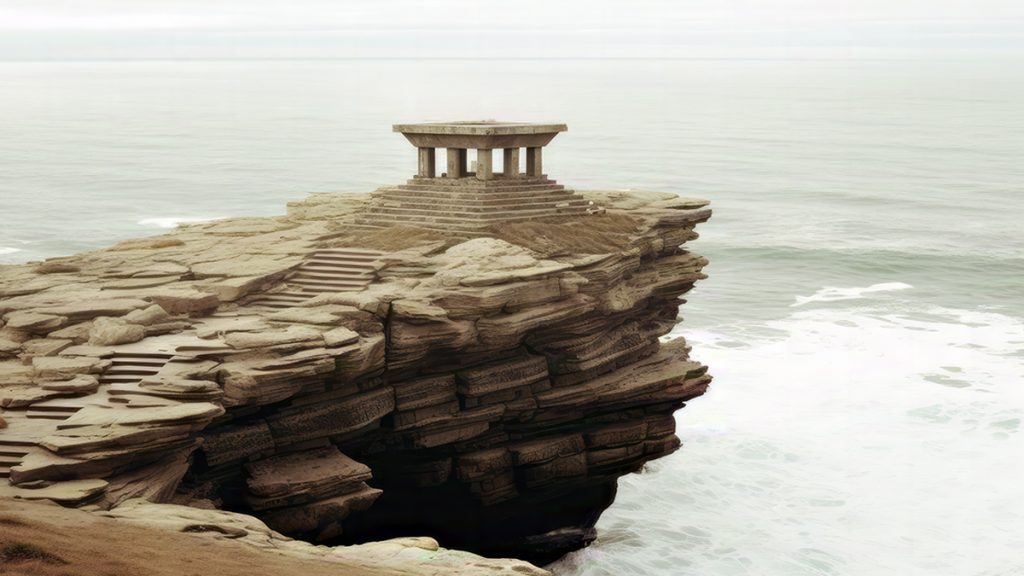Amidst the vast expanse of Arcadia, a remarkable and audacious mission began to unfold—the Great Project of Life. In the year 5304 LCE, the leaders of this extraordinary endeavor set forth on a perilous journey to recruit workers who would undertake a groundbreaking task. Their ambitious goal was to construct platforms at the edges of the world, a feat unlike anything attempted before. The purpose was twofold: to appease the gods and to make their divine presence more tangible and visible to the mortal realm.
In the heart of Arcadia, an audacious vision took shape—The Great Project of Life, conceived by Kempe. Its purpose was to construct platforms that would make the gods more visible on the land, redefining the relationship between mortals and the divine.
At the core of this project was Kempe’s visionary idea, ignited by the wisdom of the Ancient Oracle of Arcadia. Kempe, drawn to the oracle’s profound insights into the divine-Arcadian connection, aimed to bring the gods closer to mortals. Through a mystical encounter, he shared his vision with Jasapha, a revered religious leader in the Medici Principality. Recognizing Jasapha’s spiritual fortitude and unwavering dedication, Kempe knew he had found the ideal leader to embark on this momentous mission.
Initially caught off guard, Jasapha hesitated to accept such a daunting mission, due to its dangers and the potential impact on his family. However, after days of contemplation, he realized that his commitment to Kempe and the gods outweighed worldly responsibilities. With a mixture of fear and excitement, he reluctantly agreed. The recruitment process for the Great Project of Life was rigorous, seeking individuals with unwavering faith, deep knowledge of Arcadian traditions, and a strong commitment to preserving their culture. It was a call to those who carried the hopes and dreams of Arcadia within their hearts, individuals who recognized the weight of their responsibility. Many were recruited from the Talossian Guard and the Great Military encampment, as these warriors demonstrated unwavering passion for the gods, military strength, and expertise. Some, despite their inexperience, volunteered on their own, but Jasapha recognized their passion and potential, and recruited them nonetheless. Through a series of tests and spiritual evaluations, the chosen Arcadians emerged as a diverse and dedicated group, united in their unwavering resolve to honor their land and commune with the gods.
With the vision in place, the Arcadians faced the daunting task of sourcing materials for the construction of the platforms. Arcadia, blessed with abundant natural resources, provided a bountiful array of materials—from sturdy timber hewn from ancient forests to stones hauled from majestic quarries. Guided by Kempe’s intimate knowledge of the land, the Arcadians ventured far and wide, procuring the necessary materials with reverence and respect for their surroundings. Kempe sought the help of Artimia, the Goddess of Forests, who blessed the project and granted the Arcadians wisdom and strength in sourcing the right trees. Kempe also sought the guidance of Jarn, the God of Smithing, who aided the team in crafting the machinery necessary.
The placement of the platforms demanded meticulous precision. Kempe’s wisdom, inspired by the oracle and honed through exploration, guided the Arcadians in selecting the perfect locations. Drawing upon ancient ley lines and celestial alignments, they positioned the platforms with utmost care, ensuring each one held a unique connection to the divine realm. It was a remarkable fusion of Arcadian ingenuity and divine inspiration—a harmonious bridge between mortals and the celestial.
The determination, precision, and passion displayed in this project extend beyond its physical aspects; they can be connected to broader societal, historical, and cultural contexts. The Great Project of Life resonates with humanity’s eternal quest for divine connection and the desire to bridge the gap between mortal existence and the divine realm. One can seemingly draw parallels between this and historical and mythological narratives, like the Tower of Babel.
Months passed, and more individuals joined the project as they witnessed its magnitude and realized the opportunity it presented to feel closer to the gods. Many who were not directly involved supported the endeavor through financial donations, food, safety clothing, and prayers for the builders’ well-being. Experts in various fields offered their expertise and assistance in crafting weapons and felling trees. After what seemed like an eternity, the project was finally completed, with Einvaldi’s platform being the last to be crafted—a symbolic act led by Kempe himself. This act acknowledged that without Einvaldi, the God of Existence, none of the Arcadians or even Kempe would have existed. It highlighted Kempe’s multifaceted nature, his intelligence, and his encompassing role as a god.
The Great Project of Life stands as a testament to the Arcadians’ enduring pursuit of divine connection and their unwavering commitment to preserving their cultural heritage. It represents an audacious attempt to bring mortals closer to the divine, bridging the chasm between realms. The construction of the platforms symbolizes a tangible path to transcendence, where gods and mortals can coexist in harmony and understanding. The significance of this endeavor extends beyond the physical structures themselves; it embodies the resolute spirit of a civilization on the brink of transformation, yearning to transcend their mortal limitations and touch the realm of the gods.
You can explore these divine platforms on our virtual Arcadian map, where you’ll discover the sacred bond between mortals and gods and appreciate the remarkable achievements of the Great Project of Life.
Read More: Transforming Communication in Arcadia: Rodof’s Impact



